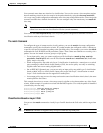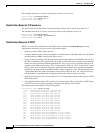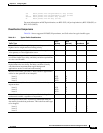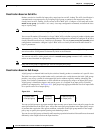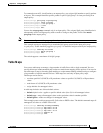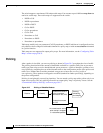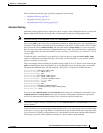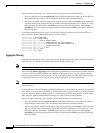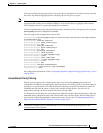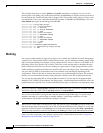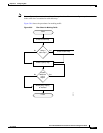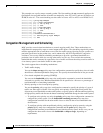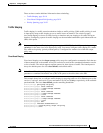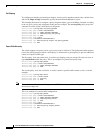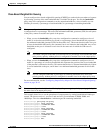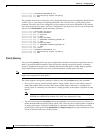
30-15
Cisco ME 3400 Ethernet Access Switch Software Configuration Guide
78-17058-01
Chapter 30 Configuring QoS
Understanding QoS
After you configure the aggregate policer, you create a policy map and an associated class map, associate
the policy map with the aggregate policer, and apply the service policy to a port.
Note Only one policy map can use any specific aggregate policer. Aggregate policing cannot be used to
aggregate traffic streams across multiple interfaces. It can be used only to aggregate traffic streams
across multiple classes in a policy map attached to an interface.
After you configure the policy map and policing actions, attach the policy to an ingress port by using the
service-policy interface configuration command.
The class maps in this example refer to access lists.
Switch(config)# policer aggregate agg1 cir 23000 bc 10000 conform-action set-dscp-transmit
46 exceed-action drop
Switch(config)# class-map testclass
Switch(config-cmap)# match access-group 1
Switch(config-cmap)# exit
Switch(config)# class-map videoclass
Switch(config-cmap)# match access-group 2
Switch(config-cmap)# exit
Switch(config)# policy-map testexample
Switch(config-pmap)# class testclass
Switch(config-pmap-c)# police aggregate agg1
Switch(config-pmap-c)# exit
Switch(config-pmap)# class video-class
Switch(config-pmap-c)# police aggregate agg1
Switch(config-pmap-c)# exit
Switch(config-pmap)# exit
Switch(config)# interface fastethernet0/1
Switch(config-if)# service-policy input testexample
Switch(config-if)# exit
For configuration information, see the “Configuring Input Policy Maps with Aggregate Policing” section
on page 30-39.
Unconditional Priority Policing
Priority policing applies only to output policy maps. You can use the priority policy-map class
configuration command in an output policy map to designate a low-latency path, or class-based priority
queuing, for a specific traffic class. With strict priority queuing, the packets in the priority queue are
scheduled and sent until the queue is empty, at the expense of other queues. Excessive use of
high-priority queuing can create congestion for lower priority traffic.
To eliminate this congestion, you can use the priority with police feature (priority policing) to reduce the
bandwidth used by the priority queue and allocate traffic rates on other queues. Priority with police is
the only form of policing supported in output policy maps. See also the “Configuring Output Policy
Maps with Class-Based Priority Queuing” section on page 30-48.
Note You cannot configure a policer committed burst size for an unconditional priority policer. Any
configured burst size is ignored.



